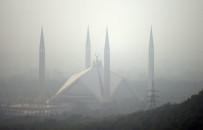Karachi at a standstill
Natural waterways that once served as Karachi's lifeline, Malir, Lyari rivers become conduits of destruction

The country's economic hub once again finds itself paralysed under the weight of torrential monsoon rains. For days, Karachi has witnessed a relentless downpour, pushing the city into a near standstill. The crisis was compounded when waters from Thaddo Dam near Saadi Town spilled over, inundating major arteries and choking urban life. What should have been a manageable natural event has instead snowballed into a civic catastrophe, exposing the true reality of how fragile Karachi's infrastructure really is.
The natural waterways that once served as Karachi's lifeline — the Malir and Lyari rivers — have become conduits of destruction. Instead of channeling the floodwaters safely out to sea, these routes are clogged and dysfunctional, forcing water back into residential neighbourhoods. From Gharibabad and Liaquatabad to the National Stadium and Surjani Town, entire localities have submerged. Alarming scenes unfolded along the M-9 Motorway, where overflowing waters from Thaddo Dam cut off the city's critical transport artery. Rescue teams scrambled as rickshaws and vans were pulled under by the current, while residents of Malir and surrounding goths watched helplessly as floodwaters invaded their homes. In Quaidabad, erosion along the Malir river prompted emergency construction of a protective embankment to stave off further damage.
These episodes are symptoms of long-neglected urban planning. Karachi's natural drainage systems have been systematically encroached upon, while unchecked urban sprawl has left little space for floodwaters to disperse. The way forward lies in reclaiming and restoring natural waterways and investing in modern drainage infrastructure. This should be coupled with enforcing strict checks against illegal encroachments that block the city's flow. Long-term planning must replace knee-jerk fixes, with accountability mechanisms to ensure that both provincial and municipal agencies deliver on flood management.















COMMENTS
Comments are moderated and generally will be posted if they are on-topic and not abusive.
For more information, please see our Comments FAQ